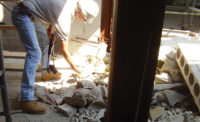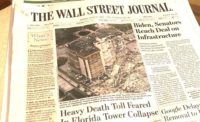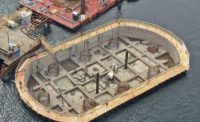
Charles Whiting Baker, chief editor of Engineering News, was vacationing in Vermont in August 1907 when word reached him that the Quebec Bridge, under construction near Quebec City across the border in Canada, had collapsed.
Expected to be the longest cantilever bridge in the world, it gave way and 20,000 tons of steel fell into the St. Lawrence River.
Eighty five workers had no time to reach shore. Seventy four died, including 33 Mohawk ironworkers. Baker quickly sent a telegram to his office, summoning Frederick Schmitt to join him at the scene of the disaster. Both Baker and Schmitt were engineering school graduates, and Schmitt had worked for a bridge fabrication company before joining the publication.
They were given complete access to the site, interviewed survivors, and Schmitt “repeatedly risked his life on what was left of the cantilever arm,” according to Endless Frontiers, a 1959 book on the history of journalism. Within four days Schmitt produced a 10,000-word article, in which by a process of elimination he identified the most probable cause. He described how the failure could not have occurred in any of the tension members because their eyebars were found intact in the wreckage. But the compression members showed signs of buckling. His article stated “the initial cause of the wreck seems to be the failure of some compression member in the anchor arm of the cantilever.” He went further and fingered the ninth chord member of the left truss. Six months later an exhaustive investigation by the Canadian Royal Commission reached the same conclusion.
The bridge was designed to carry two railroad tracks, two trolley tracks, two vehicle lanes and two pedestrian paths. Its designer was Theodore Cooper, an engineer who had designed iron and steel bridges in Pittsburgh, Rhode Island and New York City, and had authored a paper on the use of steel in railway bridges. He was a consultant to owner Quebec Bridge Co., and helped select Phoenix Bridge Co. of Pennsylvania to handle fabrication and erection of the superstructure.
Late in the design process Cooper decided to increase the length of the main span from 1,600 ft to 1,800 ft. He stated that by doing this the bridge piers would be located closer to shore, reducing the dangers of damage by ice and shortening their construction time. The commission found that the stresses on the bridge members had not been recalculated after Cooper increased the span length. This error was discovered and brought to his attention, and he made a new estimate of the stresses: 7% greater. As a result the weight of the bridge increased by 18%, but this was overlooked by engineers at both Phoenix and the Quebec Bridge Co. By the time the error was discovered much of the fabrication had been completed and erection was well advanced. Cooper decided to accept these heavier loads and stresses as being within acceptable limits.
The commission also identified a failure of oversight as another factor in the collapse. Canada’s minister of railways and canals recommended that his agency hire an engineer to double-check Cooper’s work and have final authority. Cooper, the Quebec Bridge Co. and Phoenix objected strongly, and the minister backed down. Cooper, based in New York City and in his sixties during his period of work on the bridge, was in poor health and never visited the project once construction commenced on the superstructure. He relied on reports from his deputy, engineer Norman McLure and others.
In addition to the design error there were warning signs during construction. In 1905, chord A9L had been dropped and bent while being handled in the storage yard. It was repaired and put in position, and the repair was thought to be satisfactory. Deflections in various members, including A9L, were first noticed in June 1907. McLure reported these to Cooper, but neither was alarmed. Deflections in more chords were found in August. Some of the workers had noticed the deflections and were concerned enough to not report for work for a few days. On Aug. 27, construction foreman E.R. Kinloch halted work on the bridge. The next day McLure traveled to New York to meet with Cooper.
Kinloch changed his mind, and work resumed. He was backed up by the Quebec Co.’s chief engineer, Edward Hoare, who had notified Cooper that “the moral effect of holding up the work would be very bad on all concerned and might also stop the work for this season on account of losing the men.” There had been a three-day strike over working conditions earlier that summer, and some dissatisfied workers had left, reducing the number of workers on site significantly.
Unaware that work had resumed, McLure and Cooper met briefly in New York City. Cooper wired Phoenix Bridge Co., “Add no more load to the bridge until after due consideration of facts. McLure will be over at five o’clock.” McLure traveled to Pennsylvania and was in a meeting with the chief engineer of Phoenix when the bridge collapsed.






Post a comment to this article
Report Abusive Comment